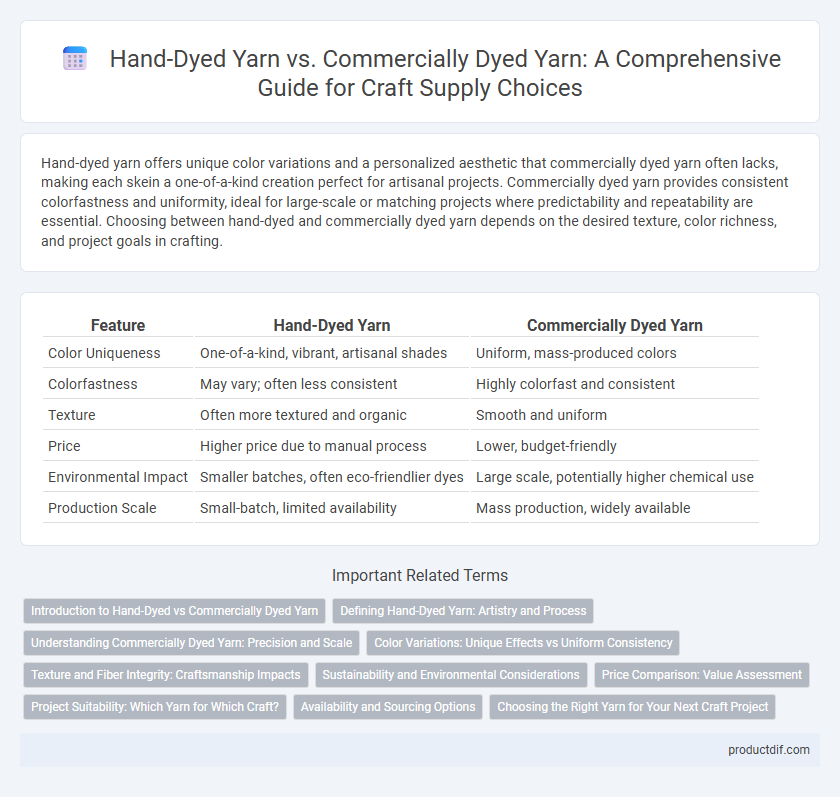Hand-dyed yarn offers unique color variations and a personalized aesthetic that commercially dyed yarn often lacks, making each skein a one-of-a-kind creation perfect for artisanal projects. Commercially dyed yarn provides consistent colorfastness and uniformity, ideal for large-scale or matching projects where predictability and repeatability are essential. Choosing between hand-dyed and commercially dyed yarn depends on the desired texture, color richness, and project goals in crafting.
Table of Comparison
| Feature | Hand-Dyed Yarn | Commercially Dyed Yarn |
|---|---|---|
| Color Uniqueness | One-of-a-kind, vibrant, artisanal shades | Uniform, mass-produced colors |
| Colorfastness | May vary; often less consistent | Highly colorfast and consistent |
| Texture | Often more textured and organic | Smooth and uniform |
| Price | Higher price due to manual process | Lower, budget-friendly |
| Environmental Impact | Smaller batches, often eco-friendlier dyes | Large scale, potentially higher chemical use |
| Production Scale | Small-batch, limited availability | Mass production, widely available |
Introduction to Hand-Dyed vs Commercially Dyed Yarn
Hand-dyed yarn offers unique color variations and artisanal quality, reflecting the craftsperson's skill and creativity, while commercially dyed yarn provides consistent and uniform color ideal for large-scale projects. Each dyeing method impacts fiber texture and saturation, influencing the final appearance and feel of the knitted or crocheted fabric. Choosing between hand-dyed and commercially dyed yarn depends on project needs, budget, and desired aesthetic effects.
Defining Hand-Dyed Yarn: Artistry and Process
Hand-dyed yarn showcases unique color variations and depth achieved through meticulous manual dyeing techniques that highlight the artisan's creativity and skill. Each skein is distinct, reflecting small batch processes that emphasize quality over uniformity, contrasting sharply with the consistent tones of commercially dyed yarn. This handcrafted approach results in vibrant, textured fibers ideal for crafters seeking originality in their knitting and weaving projects.
Understanding Commercially Dyed Yarn: Precision and Scale
Commercially dyed yarn is produced using industrial-scale machinery that ensures consistent color application and uniformity across large batches, making it ideal for mass production and retail distribution. The precision in temperature control, dye concentration, and timing during the commercial dyeing process results in highly replicable colors that meet strict quality standards. This scalability and accuracy make commercially dyed yarn a reliable choice for projects requiring color consistency and bulk availability.
Color Variations: Unique Effects vs Uniform Consistency
Hand-dyed yarn offers unique color variations with subtle shifts and irregularities that create distinctive effects ideal for artisanal projects. Commercially dyed yarn maintains uniform consistency in color, ensuring predictable results for large-scale or pattern-specific work. Choosing hand-dyed yarn enhances the individuality of each creation, while commercially dyed yarn provides reliability and exact color matching.
Texture and Fiber Integrity: Craftsmanship Impacts
Hand-dyed yarn preserves superior fiber integrity due to small-batch, artisanal dyeing processes that minimize chemical exposure and mechanical stress. This careful craftsmanship enhances texture, resulting in a softer, more resilient finish compared to commercially dyed yarns, which often undergo mass production techniques that can weaken fibers. The artisanal approach ensures unique color variations and maintains the yarn's structural quality, ideal for high-end knitting and weaving projects.
Sustainability and Environmental Considerations
Hand-dyed yarn often uses eco-friendly, low-impact dyes and supports small-scale artisans, promoting sustainable craft practices with reduced chemical waste. In contrast, commercially dyed yarn typically relies on synthetic dyes and mass production methods that generate higher water pollution and carbon emissions. Choosing hand-dyed yarn contributes to environmental conservation by minimizing harmful industrial processes and promoting biodegradable, less chemically intensive materials.
Price Comparison: Value Assessment
Hand-dyed yarn typically commands higher prices due to artisanal techniques and unique color variations, offering greater value for crafters seeking exclusivity and originality. Commercially dyed yarn is more affordable, benefiting from mass production and consistent color batches, making it ideal for large-scale projects or budget-conscious buyers. Evaluating price against project requirements determines whether the premium cost of hand-dyed yarn justifies its aesthetic and qualitative advantages over widely accessible commercial options.
Project Suitability: Which Yarn for Which Craft?
Hand-dyed yarn offers unique color variations and rich textures ideal for artisanal knitting, crochet projects, and personalized garments that emphasize individuality. Commercially dyed yarn provides uniform color consistency, making it suitable for large-scale or pattern-driven projects requiring precise color repeats and mass production. When choosing yarn for crafting, consider hand-dyed yarn for creative, one-of-a-kind pieces, while commercially dyed yarn excels in projects demanding predictability and color uniformity.
Availability and Sourcing Options
Hand-dyed yarn offers limited availability, often sourced from small-scale artisans or specialty dye studios, resulting in unique color variations and exclusive batches. Commercially dyed yarn is widely available through mass production channels, providing consistent color options and bulk quantities suitable for large projects. Access to hand-dyed yarn requires proactive engagement with niche suppliers or craft fairs, while commercially dyed yarn can be sourced easily from major craft retailers and online stores.
Choosing the Right Yarn for Your Next Craft Project
Hand-dyed yarn offers unique color variations and artisanal quality that enhance the texture and depth of handmade creations, making it ideal for personalized projects. Commercially dyed yarn provides consistent color and uniformity, ensuring predictable results and easier color matching for larger or more complex crafting. Selecting between hand-dyed and commercially dyed yarn depends on the desired aesthetic, project scale, and the importance of color consistency in your craft work.
Hand-dyed yarn vs Commercially dyed yarn Infographic

 productdif.com
productdif.com